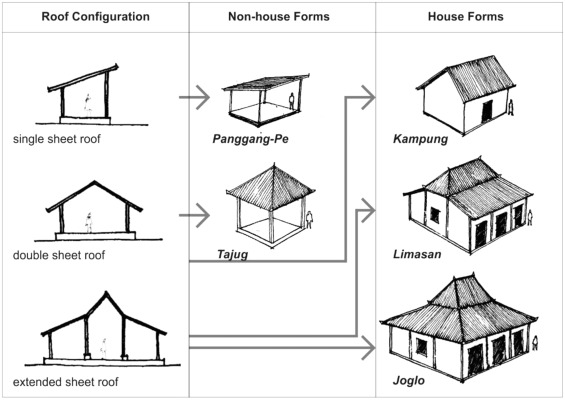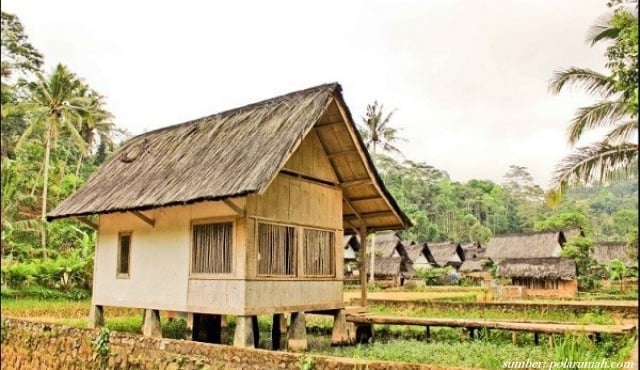
Traditional Limasan House of Trajumas Lawakan: An Architectural Overview
Indonesia is renowned for its rich cultural diversity and unique traditional architectures that reflect the history, beliefs, and social structures of its various regions. Among these architectural treasures is the Rumah Limasan Trajumas Lawakan, a traditional house that embodies the distinctive cultural identity of certain Indonesian communities. This article explores the origins, design, cultural significance, and preservation efforts surrounding this iconic structure, providing a comprehensive understanding of its role in Indonesian heritage.
Introduction to Rumah Adat Rumah Limasan Trajumas Lawakan
The Rumah Adat Rumah Limasan Trajumas Lawakan is a traditional Indonesian house characterized by its distinctive shape and cultural symbolism. "Rumah Adat" refers to traditional houses that serve as cultural symbols and functional dwellings within communities. The Limasan style, originating from Minangkabau and other regions, features a tiered roof resembling a pyramid or a stepped gable. The addition of "Trajumas Lawakan" signifies specific regional or stylistic variations that incorporate unique architectural elements and cultural motifs. These houses are more than mere residences; they are embodiments of cultural identity and social values, often used in ceremonies and communal gatherings.
This particular style of Rumah Limasan is distinguished by its elegant and intricate roof design, which is often decorated with carvings, motifs, and symbolic representations. The house structure typically includes a raised platform, wooden walls, and a prominent roof that signifies social status, spiritual beliefs, and regional identity. The layout often emphasizes harmony with nature, with open spaces that facilitate community interaction. Overall, Rumah Limasan Trajumas Lawakan exemplifies Indonesian ingenuity in blending functionality with artistic expression.
In various regions of Indonesia, Rumah Limasan Trajumas Lawakan has adapted to local environments and cultural influences, resulting in diverse yet recognizable architectural forms. Its continued existence underscores the importance of preserving traditional building techniques and cultural practices. Whether used as a family home, a ceremonial venue, or a cultural symbol, these houses play a vital role in maintaining Indonesia’s rich cultural fabric.
The significance of Rumah Limasan Trajumas Lawakan extends beyond aesthetics; it reflects social hierarchy, spiritual beliefs, and communal values. As a living tradition, it connects generations and serves as a tangible link to Indonesia’s historical and cultural roots. Understanding this architectural style provides insights into the broader cultural landscape of Indonesia, highlighting the importance of preserving such heritage amid modernization.
Historical Background of Rumah Limasan Architecture in Indonesia
The history of Rumah Limasan architecture in Indonesia can be traced back centuries, rooted in the indigenous construction techniques and cultural practices of various ethnic groups. Originating from regions such as Minangkabau in West Sumatra, the Limasan style evolved as a response to environmental conditions, social structures, and spiritual beliefs. Its distinctive tiered roof design was inspired by traditional symbolic motifs, representing harmony with nature and the universe.
Historically, Rumah Limasan served both as a residence and a communal space for social and cultural activities. Its elevated structure provided protection from flooding and pests, while the open layout facilitated social interactions among inhabitants. The architecture also reflected social hierarchy, with larger and more elaborately decorated houses reserved for community leaders or wealthier families. Over time, these houses became symbols of regional identity and cultural pride.
During the spread of Islam and other religious influences in Indonesia, Rumah Limasan incorporated elements that reflected spiritual beliefs, such as auspicious motifs and symbolic carvings. The houses often became focal points for traditional ceremonies and rituals, reinforcing their cultural significance. Colonial encounters and modernization introduced new materials and techniques but did not diminish the core architectural principles of the Limasan style.
Throughout history, the design of Rumah Limasan has adapted to regional variations, influenced by local materials, climate, and cultural nuances. Despite these differences, the fundamental features—such as the tiered roof, wooden construction, and elevated platform—remain consistent. This resilience highlights the architectural style’s deep roots and its importance as a cultural icon in Indonesia’s historical landscape.
Today, Rumah Limasan architecture stands as a testament to Indonesia’s rich cultural history. Preservation efforts aim to safeguard these structures from decay and modernization threats, recognizing their role in cultural identity and heritage. Studying the historical development of Rumah Limasan provides valuable insights into Indonesia’s social evolution, environmental adaptation, and artistic expression over centuries.
Unique Architectural Features of Rumah Limasan Trajumas Lawakan
The Rumah Limasan Trajumas Lawakan is renowned for its distinctive architectural features that set it apart from other traditional houses in Indonesia. The most prominent characteristic is its tiered, pyramidal roof, called "Limas," which resembles a stepped pyramid or a series of overlapping layers. This roof not only provides aesthetic appeal but also symbolizes spiritual harmony and social status within the community.
The roof construction involves intricate wooden joinery and carvings, often decorated with motifs that reflect local cultural symbols, such as animals, plants, or spiritual icons. The eaves extend outward, providing shade and protection from rain, while also serving as a canvas for decorative elements. The roof’s steep pitch facilitates water runoff, making it suitable for Indonesia’s tropical climate.
The house structure itself is built on a raised platform, called "balai," which elevates the living space above ground level. This design protects against flooding, pests, and humidity. The walls are typically made of wood or bamboo, with lattice or carved panels that allow ventilation and light to enter. The openings are often decorated with traditional patterns, adding to the aesthetic appeal.
Another notable feature is the layout of the house, which emphasizes harmony and balance. The main living area is usually centrally located, with auxiliary spaces for storage, ceremonies, or communal activities. The use of natural materials and craftsmanship reflects a deep respect for local resources and artisanal skills. Overall, the architectural features of Rumah Limasan Trajumas Lawakan embody a blend of functionality, spirituality, and artistic expression.
The craftsmanship involved in constructing these houses is highly regarded, with artisans passing down techniques through generations. The structural design and decorative elements are carefully integrated to create a harmonious whole that embodies cultural values and regional identity. These features make Rumah Limasan Trajumas Lawakan not only a dwelling but also a cultural artifact that narrates the community’s history and beliefs.
Cultural Significance of Rumah Adat in Indonesian Society
Rumah Adat, including the Rumah Limasan Trajumas Lawakan, holds profound cultural significance in Indonesian society. These traditional houses serve as symbols of identity, social cohesion, and cultural heritage for local communities. They embody the values, beliefs, and social structures that have been passed down through generations, functioning as more than just physical structures.
In many regions, Rumah Adat is the venue for important life events such as weddings, rites of passage, and communal ceremonies. The house’s design and layout often reflect social hierarchies and family lineage, reinforcing community cohesion and respect for tradition. Its presence in the community symbolizes continuity, stability, and the preservation of cultural identity amidst changing times.
Furthermore, Rumah Adat often incorporates spiritual and symbolic elements that are believed to bring protection, prosperity, and harmony. Decorative motifs, carvings, and architectural features are imbued with cultural meanings, serving as a visual language that communicates community values and spiritual beliefs. These houses thus act as physical manifestations of cultural narratives and collective memory.
In addition to their spiritual and social roles, Rumah Adat also functions as a cultural showcase, attracting visitors and promoting local traditions. They are often featured in cultural festivals, exhibitions, and educational programs aimed at preserving Indonesia’s diverse heritages. The house’s aesthetic and symbolic elements foster pride among community members and serve as a link to their ancestral roots.
Today, the cultural significance of Rumah Adat remains vital in maintaining Indonesia’s cultural diversity. They provide a sense of identity and continuity for indigenous communities, anchoring their social and spiritual lives. Recognizing their importance encourages efforts to preserve these structures as vital components of Indonesia’s intangible and tangible cultural heritage.
Materials and Construction Techniques of Rumah Limasan
The construction of Rumah Limasan Trajumas Lawakan relies heavily on locally available natural materials and traditional craftsmanship. Wood is the primary material used for the framework, walls, and decorative elements, chosen for its durability, availability, and ease of carving. Bamboo, rattan, and thatch are also commonly used for roofing, wall panels, and interior furnishings.
The materials are carefully selected and prepared by skilled artisans who employ age-old techniques passed down through generations. For example, timber is seasoned to prevent warping, while bamboo is treated to resist pests and decay. The wooden joinery often involves intricate interlocking techniques that do not require nails, emphasizing craftsmanship and cultural craftsmanship.
Construction techniques focus on sustainability, adaptability to the environment, and cultural symbolism. The raised platform is built using sturdy wooden stilts, which protect the house from flooding and pests. The roof construction involves layered wooden beams and rafters, with detailed carvings and decorative elements that also serve structural purposes. Ventilation is achieved through the strategic placement of windows, lattice panels, and open spaces.
Traditional artisans also incorporate symbolic motifs into the construction process, ensuring that each element reflects cultural values. For example, the carvings may depict animals, plants, or spiritual symbols believed to bring protection or good fortune. The craftsmanship involved requires patience, precision, and a deep understanding of local materials and techniques.
Modern preservation efforts emphasize the importance of maintaining these traditional construction methods to ensure the authenticity and sustainability of Rumah Limasan. While some contemporary adaptations may incorporate modern materials, the core techniques and principles remain rooted in tradition. This approach helps preserve the cultural integrity and environmental harmony of these architectural masterpieces.
Regional Variations of Rumah Limasan in Indonesia
Although the Rumah Limasan style is recognized across Indonesia, regional variations exist that reflect local cultural influences, environmental conditions, and available materials. In West Sumatra, for example, the Minangkabau Rumah Limasan features elaborate carvings, curved rooflines, and distinctive motifs that symbolize local spiritual beliefs. The roof often resembles buffalo



